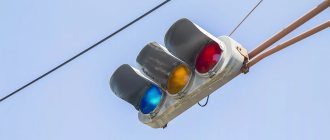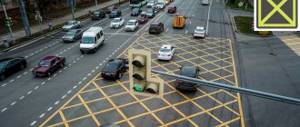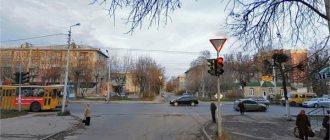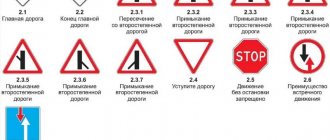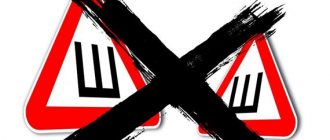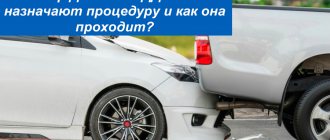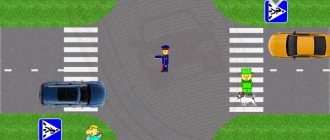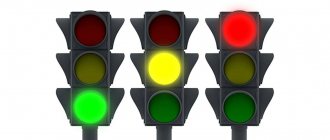Comments: no Published: 11/10/2019
Rating:
Many novice drivers are afraid to drive into busy areas of the city, becoming very lost at intersections. And although the theoretical course at a driving school examines this issue in some detail, the ability to apply one’s knowledge in practice does not come immediately, and controversial situations do not increase self-confidence.
Basic rules for driving through an intersection with a traffic light
A controlled intersection is one where traffic is controlled by a traffic light or a traffic controller. It is worth noting that driving through areas with such regulation is much easier than using priority signs, because it is not always clear which of them are intended for drivers in the oncoming and adjacent lanes.
Thus, the green signal of the device, which is permissive, allows you to pass through the intersection, regardless of what priority signs are placed on it. Another thing is that the priority is regulated by the direction of movement of the vehicle, because it is one thing if it goes straight and to the right, and quite another thing when it is necessary to make a left turn or turn around.
Right
By turning right on the main green signal, the driver gains priority over all other cars moving in the opposite or adjacent direction.
The only road users who will have to give way when performing such a maneuver are pedestrians crossing the adjacent zebra crossing.
See also:
When is a fine possible when crossing the rightmost continuous line on the road?
Left or U-turn
Things are a little more complicated if a motorist driving towards the permitting signal of the main (round) section of the road control device needs to turn left or turn around right at the intersection, although even here there is a simple algorithm, mastering which will help you not get lost in the future. According to it, a motorist performing any of the mentioned maneuvers must yield:
- anyone moving straight in the opposite direction;
- to everyone who turns left while driving in oncoming traffic;
- pedestrians crossing the road in the adjacent lane after making a maneuver.
As for the oncoming passing of vehicles turning left, it is carried out in two ways: without crossing each other’s path with their right sides or with crossing the conventional path of movement with their left sides. You have to choose the optimal of these two methods on the spot, based on the configuration of the intersection and the behavior of other drivers.
In this case, it is recommended to drive to the center line of the intersection, let all oncoming traffic pass and complete your maneuver. You cannot act in this way if a sufficient number of cars have already accumulated in the center of the intersection, otherwise you can create a traffic jam.
It will be possible to turn around in such a place only if there is no sign next to the permitting signals prohibiting such a maneuver. In addition, a sign with a crossed out left turn is interpreted as permission to change the direction of travel.
If the prohibitory light comes on, the car that has managed to enter the intersection must complete the maneuver, making sure that those whose green light is already on are allowing it to pass.
Directly
Driving directly to the main traffic light signal gives the vehicle driver complete privilege. This means that he will not have to let oncoming cars or cars driving in the adjacent lane pass, as well as pedestrians, for whom the prohibiting signal should automatically light up.
An exception may be sections of roads with unregulated pedestrian zones, because in this case those who walk along the zebra crossing will have a privilege.
Traffic rules with traffic lights and priority signs
It is important to remember that traffic priority signs, which always back up traffic lights in case they break down or are turned off at night when traffic is lighter, will only have priority in the latter two situations. Simply put, you only need to follow the signs when the optical signaling device is not working.
Also, the green light automatically eliminates the concept of a main and secondary road, as well as an obstacle on the right, especially since changing lanes at an intersection is only allowed if there is a traffic jam or an accident ahead, and it is possible to get around them.
See also:
Instructions from the regulator: what could be the consequences if not followed?
How much does a traffic light cost?
The cost of the simplest three-section traffic light type T1 starts at 15,000 rubles. This is the basic minimum; the final price depends on the type and number of traffic lights at the intersection, as well as the difficulty of installation. For example, a traffic light facility on Yablochkova Street cost 1,214,140 rubles, and at the intersection of Trubetskaya Street and Usachev Street - 5,290,390 rubles. Several million rubles is the average Moscow price for turnkey intersection equipment; it includes the installation of not only traffic lights, but also road signs, signs, fences, as well as markings.
All traffic lights in the capital are of domestic production (including Moscow), but they may use imported components.
All traffic lights in the capital are of domestic production (including Moscow), but they may use imported components.
Traffic at an intersection with additional traffic light sections - in pictures
Do not confuse the additional traffic light section with a sign with a green arrow, which is fixed next to the red main signal, allowing traffic, provided that it does not interfere with those who have priority.
At night, the section becomes invisible, so the main signal of the optical device helps to know about its presence, in which, in addition to the color fill, a contour pattern is duplicated, indicating possible directions of movement.
The section does not allow movement
Movement along the section, which can be located either to the right or to the left of the device, allowing turns in the corresponding directions, is considered prohibited if it is not lit or shows a prohibited signal. In such situations, further movement in the given direction will be considered unacceptable until the green light turns on.
If, after standing for several cycles and without waiting for the coveted permission, the driver understands that the section is not working, then you should navigate by the main one.
See also:
New traffic rules from January 1, 2021: insurance, “spikes” and “disabled” signs, road accidents
The traffic light and section are green
If both the section and the main signal light up in a permissive color, this means that drivers occupying the outer row corresponding to the additional lens can perform the maneuver, while those standing in the middle lane have the right to continue driving straight.
If at the same time you have to turn left along the section, then you should be prepared for the fact that you will have to give way to those who are going straight and to the right in the oncoming traffic, as in the case of driving along the main traffic light.
As for turns to the right, in this case you only need to let pass pedestrians and those who remained at the intersection without having time to complete the maneuver at their permission signal.
The traffic light is red, the arrow is green
Inexperienced drivers are often confused when, in parallel with the green arrow of the additional section, a signal prohibiting the base lights up, although it has nothing to do with them, not allowing further movement only for those moving in other directions.
If it is necessary to turn left along a green sectional arrow, then there is a high probability that the motorist will not have to let anyone pass, since the red light will also be on for the oncoming direction.
Inactive arrows
If, at a traffic light equipped with one or even several additional sections, only the main lenses light up, then the driver has the right to maneuver in the direction he needs.
At the same time, such actions can only be performed with the main light on, provided that they do not interfere with the movement of drivers traveling in the oncoming and adjacent direction.
Directions
You can drive straight at a road intersection equipped with side sections only if the main green light is on. In addition, you can safely follow in a given direction when, along with the main lens, an additional one that allows or prohibits movement is lit, with priority for the first category of drivers. In all other cases, driving in a straight line will be considered a serious violation, fraught with fines or criminal prosecution.
Green section at red signal level
Typically, additional sections are installed at the level of the green traffic light compartment. Next to the red lens, only a sign with a green arrow allowing a right turn, which is read completely differently, can be placed.
Unlike a sectional device, the sign operates on a permanent basis, allowing you to perform a right maneuver at any time, provided that no other vehicles follow the adjacent path to the left.
The location of the car on the road is also of great importance, because they have the right to turn right or left only from extreme positions, unless signs and road markings contradict this. In addition, being in the right/left lane, he will be required to perform a maneuver when the permissive additional signal is turned on, even if he initially planned to move straight.
This point should definitely be taken into account when changing lanes closer to the center in advance if turns in this place were not included in the routes. At the same time, the green arrow near the red lens does not oblige you to perform such actions, so the vehicle owner can continue to stand at the red light without turning, waiting for permission to drive straight.
See also:
How to drive through an uncontrolled intersection correctly - a difficult exam question at a driving school
Traffic lights installed at railway crossings
This traffic light is installed directly at railway crossings in combination with “STOP” and “Stopping Place” road signs, respectively. Usually consists of two horizontally spaced red sections and one additional moon-white section. The white section is located between the red ones, below or above the sections connecting them. The meaning of the signals is as follows:
- two alternately flashing red signals - movement through the crossing is prohibited; this signal is usually duplicated by an audio alarm (bell);
- A flashing moon-white traffic light signal means that the technical crossing system is in good working order, and also informs road users about unhindered passage through the railway crossing
Reversible traffic light
To regulate traffic along the lanes of the roadway (especially where reversible traffic is possible), special lane control traffic lights (reversible) are used. In accordance with the Vienna Convention on Road Signs and Signals, such traffic lights may have two or three signals:
- a red X
-shaped signal prohibits movement in the lane; - a green arrow pointing down allows movement;
- an additional signal in the form of a diagonal yellow arrow informs about a change in the operating mode of the lane and indicates the direction in which it must be left.
Traffic lights for route vehicles
To regulate the movement of route vehicles (trams, buses, trolleybuses) or the route movement of all vehicles, special traffic lights are used, the type of which differs from country to country.
In Russia, the Rules of the Road provide for the use of a T-shaped traffic light with “ four round signals of white and moon color
" The upper signals are used to indicate permitted directions of movement (left, straight, right), and the lower one allows the start of movement. Also, in recent years, in cases where there is only one direction of movement of route vehicles, or traffic is always allowed for all directions at the same time, sometimes a traffic light is used in the form of an ordinary single round section with a luminous letter “T” in yellow, allowing movement when illuminated, and prohibiting when not illuminated.
In Switzerland, a single orange signal (steady or flashing) is used for this purpose.
In the Nordic countries, traffic lights with three sections are used, the same in location and purpose as standard traffic lights, but having a white color and the shape of signs: “S” - for a signal prohibiting movement, “—” - for a warning signal, a direction arrow - for permissive signal.
There are also traffic lights at tram stations (terminal) - that is, outside highways, having 2 sections - red and green. They serve to indicate the order of departure of tram trains from different tracks of the station.
There is no international standard for traffic lights for route vehicles, and they can vary greatly even in neighboring countries. As an example, below are the signals of such traffic lights in Belgium and the Netherlands:
Signal meaning (from left to right):
- Driving straight ahead is allowed
- Driving to the left is allowed
- Driving to the right is allowed
- Movement in all directions is allowed (similar to the green signal of a car traffic light)
- Driving is prohibited unless emergency braking is required to stop (similar to a yellow traffic light)
- Traffic is prohibited (similar to a red traffic light)
Because of its specific appearance, the Dutch traffic light received the nickname negenoog, that is, “nine eyes”.
Traffic light for pedestrians
Such traffic lights regulate the movement of pedestrians through a pedestrian crossing. As a rule, it has two types of signals: permissive and prohibitive. Typically, green and red light are used for this purpose, respectively. The signals themselves have different shapes. Most often, signals are used in the form of a person’s silhouette: red for standing, green for walking. In the United States, the red signal is often performed in the form of a silhouette of a raised palm (the “stop” gesture). Sometimes the inscriptions “don’t walk” and “walk” are used (in English “Don’t Walk” and “Walk”, in other languages - similarly). In the Norwegian capital, two standing figures painted red are used to prohibit pedestrian traffic. This is done so that the visually impaired or people suffering from color blindness can understand whether they can walk or need to stand. As a rule, automatically switching traffic lights are installed on busy highways. But an option is often used when the traffic light switches after pressing a special button and allows the transition for a certain time after that.
Modern traffic lights for pedestrians are additionally equipped with sound signals intended for blind pedestrians, and sometimes with a countdown display (first appeared in France in 1998).
During the existence of the GDR, traffic light signals for pedestrians had the original form of a small “traffic light” man (German: Ampelmännchen
). In Saxony and the eastern part of Berlin, such traffic lights are still installed to this day.
In the absence of a pedestrian traffic light, pedestrians are guided by the indications of a car traffic light.
Traffic light for cyclists
To regulate the movement of bicycles, special traffic lights are sometimes used. This can be a traffic light, the signals of which are made in the shape of a bicycle silhouette, or a regular three-color traffic light, equipped with a special sign. As a rule, such traffic lights are smaller in size than car ones and are installed at a height convenient for cyclists.
Common Questions
- What are the penalties for violating these traffic rules? Even if the driver turns right or left on the main green light when the additional lights are extinguished, his action will be equivalent to driving through a prohibitory signal, which is a serious violation.
The fine for it is 1000 (Article 12.2 of the Code of Administrative Offenses of the Russian Federation). Similar sanctions will be applied if the movement was carried out directly on red during active additional sections.
- How to challenge a punishment? It will not be possible to challenge such penalties, even if they were recorded by a security camera. An exception would be the situation when, in poor visibility conditions, there was no black contour arrow indicating that the traffic control optics had additions.
Meanwhile, understanding the rules for driving even at complex intersections with traffic lights is not as difficult as it might seem initially; the main thing is to learn a simple algorithm that allows you to think quickly and make the only correct decisions.
